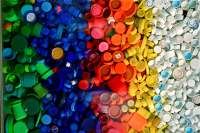Bioplastics industry prepares to blast off
When the global credit crunch occurred, many industries suffered and major companies were either bailed out by governments or forced to declare bankruptcy. The bioplastic industry was an exception.

 When the global credit crunch occurred, many industries suffered and major companies were either bailed out by governments or forced to declare bankruptcy. The bioplastic industry was an exception.
When the global credit crunch occurred, many industries suffered and major companies were either bailed out by governments or forced to declare bankruptcy. The bioplastic industry was an exception.
The economic downturn did little more than delay its advance, which is projected to pick up faster than most industries and will likely play a role in revamping the world economy with new jobs, innovative new products and a need for greater marketing and distribution.
In the past, bioplastics were not considered commercially or practically viable. Creating them was costly, inefficient, and the end product was heat sensitive and unreliable.
But scientific breakthroughs have led to an improved product and more efficient production, and bioplastics are no longer a niche product. As a result, bioplastics have seen an unprecedented increase in demand from companies and consumers alike, especially in light of an increasingly volatile oil market.
Every major bioplastic company is expanding and in the process building or opening new plants throughout the world to meet and anticipate demand.
As governments impose taxes on carbon and fossil fuel and consumers become environmentally educated, huge multinational companies have looked to improve their image and cut down their carbon footprints. One way to do so is by turning to bioplastics.
Coca-Cola is adding 15-30% sugar-cane resin to beverage bottles as a part of their "Planet Bottle" campaign. Mazda and Hyundai have incorporated PLA into the upholstery of its hybrid vehicles.
Samsung is building cell phones from bioplastic, while Frito-Lay's Sunchips are being packaged in 100% biodegradable material. Aldi Incorporated a leading German food supplier is providing bioplastic grocery bags. This is only the beginning.
The medical field has recently recognised a dire need to cut its carbon footprint-with petrol-based plastics used in packaging a leading contributor. Hospitals require equipment to be shipped in sterile packaging, which until now demanded a PET plastic film.
If bioplastics usurp PET plastics in this field worldwide, demand could increase exponentially, allowing for another boom in addition to its vast potential in consumer products.
Currently, bioplastic production is highest and expanding most rapidly in Pacifc Asian region, Europe, and the United States. But, in South America, interest is beginning to peak.
Brazil is well positioned to become a leading manufacturer of PLA-Brazil is one of the world's leading suppliers of sugarcane, which is already utilised to make ethanol more sustainably than the corn, maize or rapeseed based ethanol produced in the United States and Europe.
Brazil is a leading ethanol producer. This adolescent technology is set to grow up fast. The Japanese government has set a goal that 20% of all plastics consumed within Japan will come from a renewable resource.
Germany, Korea and Taiwan plan to phase-in a ban that will prevent solid waste comprised of more than 5% of organic waste. In the United States, the 2002 Farm Security and Rural Investment Act stipulates each federal agency build a plan to purchase as many bio-based plastics as is practically possible.
The new breakthroughs are making bioplastics all the more practical. The world's plastic consumption hovers around 500 billion pounds per year.
The world's bioplastic consumption is under 5% of the total. There is a high ceiling for bioplastics to reach; the industry expects to be worth at least $10 billion by 2020. Today's world entirely absent of plastic is incomprehensible, and bioplastics are certain to offer an alternative to the plastics we rely on today.
Author: Michael Good |Climate Action
Image: stevendepolo |Flickr






